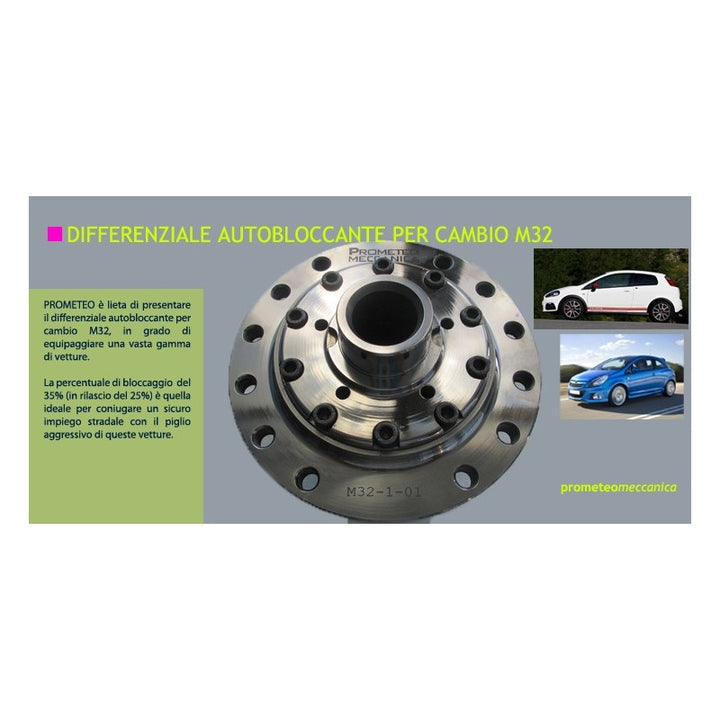Manny Abarth Store
Self-locking differential Prometeo Grande punto Abarth M32
Self-locking differential Prometeo Grande punto Abarth M32
Couldn't load pickup availability
SELF-LOCKING DIFFERENTIAL FOR M32 GEARBOX
Front-wheel drive sports cars can suffer from poor traction due to the high torque being sent to the wheels.
This is especially evident when exiting a curve, where the inside wheel is partially relieved of the weight that is on it due to the load shift caused by centrifugal force: one of the two wheels is thus able to unload a much lower torque to the ground than the other. Remember that a free differential has the characteristic of always dividing the torque into two equal parts, so the maximum torque that can be unloaded to the ground is limited by the grip of the wheel with the least load.
Several modern cars are already equipped as standard with an electronic system called TTC, which SIMULATES a self-locking differential : in practice, when one of the two drive wheels loses grip, the electronic control unit responsible for traction control sends a braking pulse to the brake caliper of the slipping wheel: the negative torque that is added to the wheel allows the normal differential to be "cheated", sending an equal torque also to the wheel with greater grip. The TTC is certainly a valid and safe system, which guarantees good control of the vehicle, however, we reiterate, it is not a self-locking differential and does not guarantee the same performance that only a good self-locking differential can provide.
If you're used to using your car on the track during track days, or you don't like having to suffer the annoying slipping of the inside wheel every time you exit a corner in a somewhat cheerful way, then a real self-locking differential could be the thing for you.
Our self-locking differential with helical gears allows the asymmetrical division of the driving torque coming from the engine, this means that the wheel with the most grip will always receive a surplus of torque compared to the less loaded wheel. The percentage of locking in traction is approximately 35% . We preferred not to go beyond this since the cars on which the differential can be mounted are road cars.
The helical gear differential has a very progressive operation and does not create unwanted effects in normal driving.
The percentage of lock-up when released is limited to approximately 25%, so as not to influence braking and cornering.
It is very difficult to explain in words the effect you get, but the sensation you get when you open the throttle after the apex of a curve and not feel the nose going off on a tangent, but pulling inwards is something unknown to a front-wheel drive with a standard differential.
Furthermore, the operation of our differential is compatible with the TTC.
How does a limited slip differential work? First, let's look at how the standard front differential works.
The differential is a device that divides the driving torque coming from the gearbox exactly in half for each of the two half-shafts, regardless of the difference in the revolutions of the two wheels of the axle itself. Therefore, as you can see in the figure, if the driving torque entering the differential is 100 (the units are completely arbitrary), a torque of 50 will end up on each wheel.
There is, however, another important parameter to consider: the grip of the tires on the ground. In fact, the torque can be "discharged" to the ground up to the grip limit of the wheel; this limit is therefore proportional to the load fraction acting on the wheel and to the grip coefficient, which depends mainly on the consistency of the ground.
So if one of the two front wheels ends up in an area with less grip (for example on slippery asphalt), the torque to the ground that can be discharged by the wheel in question is reduced, given that the wheel itself reaches the slipping condition. Due to the property of the differential mentioned above, which is that of being a mechanism that divides the input torque into equal parts, we will have the same torque value also on the other wheel which still maintains good grip.
As can be seen from the previous figure, if the value of the slip limit torque of the front left wheel is 20, the right wheel will also be able to unload a torque of 20 to the ground. And therefore the total traction of the front axle is reduced to the value of 40, significantly lower than the value of 100 in the previous example.
If we mount the Prometeo self-locking differential instead of the normal differential, traction improves in these cases. Let's see how and by how much.
First of all, in conditions of good and uniform grip, the self-locking differential behaves like a normal differential, as can be seen in the following figure.
However, if one wheel loses grip, the self-locking differential transfers a greater torque to the other wheel. The total torque discharged to the ground by the front axle is therefore greater than that discharged to the ground by a common differential. The following figure is very explanatory of this mode of operation.
The 35% locking percentage is the best compromise found through numerous tests performed in different conditions. Let's not forget that an excessive locking percentage would have made the vehicle too understeer in normal driving, with consequent problems in driving. And, on the other hand, too low a locking percentage would have reduced the benefits of the self-locking, making it objectively useless.
Contact us for any information!
Share


